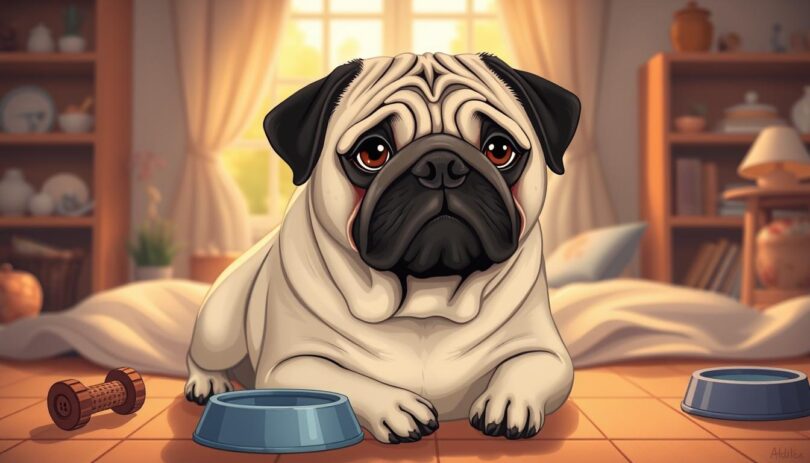Could a squishy-faced companion outlive your smartphone? While many assume small breeds have short lifespans, pugs defy expectations with surprising longevity. These compact charmers often thrive for 13-15 years – longer than some larger dogs. But what makes their journey so unique?
Their wrinkled smiles hide complex health realities. Brachycephalic features (those adorable flat faces) create breathing challenges. Curly tails and compact frames bring spinal risks. Yet with proper care, these resilient dogs frequently reach their teens.
Understanding a pug’s lifespan helps owners make informed decisions. Nutrition, exercise routines, and veterinary care become crucial tools. This article explores:
• Key factors influencing longevity
• Common health considerations
• Practical strategies to support wellbeing
Whether you’re considering adoption or already share your home with a pug, this guide offers science-backed insights. Discover how to help your four-legged friend enjoy every moment of their remarkable journey.
Understanding Pug Lifespan and Key Facts
Pugs may be small, but their lifespans pack a surprising punch. These affectionate companions typically live 12-15 years, according to a 2023 University of Georgia study. Their longevity often surpasses larger breeds like bulldogs or mastiffs, though unique challenges shape their journey.
Average Lifespan Overview
Recent veterinary research shows 68% of pugs reach age 12 when given proper care. This exceeds the 10-year average for many medium-sized dogs. However, their flat-faced structure creates specific vulnerabilities. Respiratory and spinal conditions appear 3x more frequently than in non-brachycephalic breeds.
Comparing Pugs with Other Dog Breeds
Chihuahuas often live 14-16 years, while dachshunds average 12-16. Pugs fall slightly short due to breed-specific health issues. Miniature poodles outpace both groups, frequently reaching 15+ years with fewer genetic complications.
Size plays a role – smaller dogs generally live longer than larger ones. But genetics ultimately determine outcomes. Pug owners should prioritize regular vet visits and weight management to counterbalance inherent risks. Early detection of breathing or eye problems can add years to their lives.
How Long Do Pugs Live: Examining the Numbers
Recent scientific studies shed new light on pug longevity patterns. A 2020 UK veterinary survey tracking 500 pugs found 72% reached age 12 when receiving annual checkups. This aligns with American Kennel Club data showing similar outcomes across diverse climates and diets.
Statistical Insights and Studies
Research reveals fascinating trends. A 2022 University of Pennsylvania study documented a median lifespan of 13.2 years for pugs in optimal weight ranges. Dogs exceeding healthy body weights showed 18% shorter life expectancies. Respiratory complications appeared in 41% of cases by age 10, emphasizing early intervention needs.
Comparative analysis shows consistency across sources. UK Breed Health Survey data (2023) matches US findings within 5% variance. These numbers highlight the importance of monitoring body condition and breathing patterns over time.
While statistics offer guidance, individual results vary. Regular veterinary assessments help catch emerging issues before they escalate. Owners who track nutrition and activity levels often report their companions thriving beyond average projections.
Quality care bridges genetic predispositions and real-world outcomes. Proactive management of common health concerns gives these charismatic dogs their best shot at reaching – and exceeding – expected milestones.
Breed Characteristics That Influence Lifespan
Pugs carry a fascinating genetic blueprint that shapes their journey from puppyhood to senior years. Their compact bodies hold both advantages and challenges that directly affect longevity. Let’s explore the key physical traits every owner should understand.
Size and Genetic Considerations
Small dog breeds often enjoy longer lifespans than larger counterparts. Pugs typically weigh 14-18 pounds, a factor linked to reduced joint stress and slower aging. Their genetic makeup supports resilience against age-related conditions common in bigger breeds.
However, selective breeding created vulnerabilities. Shortened snouts and curled tails stem from human preferences rather than natural evolution. These traits increase risks for spinal issues and temperature regulation challenges despite the size advantage.
Impact of Brachycephalic Features
Those signature flat faces come at a cost. Brachycephalic airway syndrome affects 90% of pugs, according to veterinary studies. Narrow nostrils and elongated soft palates restrict airflow, making even mild exercise potentially dangerous.
Owners might notice:
• Noisy breathing during rest
• Reduced heat tolerance
• Increased sleep apnea risks
Proactive care helps manage these factors. Using harnesses instead of collars reduces neck pressure. Keeping indoor temperatures cool supports easier breathing. Recognizing early signs of distress allows timely veterinary intervention.
Common Health Issues Affecting Pug Lifespan
Pugs bring endless joy with their playful antics, but their unique physique demands special attention. Three key health challenges frequently impact these charismatic companions: respiratory limitations, sensory vulnerabilities, and metabolic risks. Proactive management of these concerns helps maintain quality of life through their golden years.
Brachycephalic Airway Syndrome and Respiratory Concerns
Those signature snub noses create breathing challenges in 65% of pugs, per veterinary reports. Brachycephalic Obstructive Airway Syndrome (BOAS) narrows nasal passages and throat structures. Owners often notice snorting sounds during rest or excessive panting after brief walks.
Managing BOAS involves:
• Avoiding overheating in warm weather
• Using body harnesses instead of neck collars
• Seeking veterinary evaluation for severe cases
Skin, Eye, and Weight-Related Problems
Facial wrinkles trap moisture, leading to skin infections without daily cleaning. Prominent eyes face higher injury risks from debris or accidental scratches. A 2023 Cornell University study found 40% of pugs develop eye ulcers by age 7.
Weight management proves crucial. Excess pounds strain joints and worsen breathing difficulties. Measure food portions carefully and limit treats to 10% of daily calories. Regular vet visits help catch emerging issues early, from corneal abrasions to hormonal imbalances.
While these health issues require vigilance, most respond well to consistent care. Partnering with a trusted veterinarian creates tailored prevention plans. Simple daily routines – like wiping skin folds and monitoring activity levels – make significant long-term differences.
The Role of Diet, Exercise, and Veterinary Care
Daily routines shape a pug’s health journey more than many owners realize. Three pillars – nutrition, activity, and professional oversight – form the foundation for their wellbeing. When balanced thoughtfully, these elements work together to support vitality and address breed-specific needs.
Choosing the Right Dog Food and Supplements
High-quality kibble formulated for small breeds helps maintain ideal body weight. Look for options with omega fatty acids to support skin health and glucosamine for joint care. Measure portions carefully – pugs need only 40-50 calories per pound daily to avoid obesity.
Supplements like probiotics aid digestion, while fish oil promotes coat shine. Always consult your vet before adding new products. Treats should never exceed 10% of daily calories to prevent weight-related breathing strain.
Importance of Regular Checkups and Exercise
Short, frequent walks work better than intense workouts for these flat-faced companions. Aim for 20-30 minutes of gentle activity daily, avoiding midday heat. Use harnesses to reduce neck pressure during outings.
Bi-annual vet visits catch issues early, from dental problems to eye concerns. Bloodwork and respiratory assessments become crucial as pugs age. Proactive care helps manage conditions before they require intensive treatment.
A holistic approach combines proper food choices with modified exercise plans. Pairing these strategies with fascinating dog facts about canine biology helps owners make informed decisions. Consistent routines give these charismatic pets their best chance at thriving through every life stage.
Environmental and Lifestyle Factors for Pug Wellbeing
Creating a safe, comfortable space plays a vital role in supporting these compact companions. While their playful personalities suggest boundless energy, pugs thrive best when their unique needs shape their living environment.
Indoor Living and Climate Considerations
Pugs flourish as indoor pets due to their brachycephalic features. Central air conditioning becomes essential during summer months – temperatures above 80°F can trigger dangerous overheating. Winter brings different challenges, as dry indoor heat may irritate their sensitive respiratory systems.
Outdoor activities require careful planning. Short wrinkly dogs benefit most from morning or evening walks when temperatures stay below 75°F. Always carry water and watch for excessive panting, which signals it’s time to head home.
Three key lifestyle adjustments help owners protect their pets:
• Maintain 68-72°F indoor temperatures year-round
• Use humidifiers in winter to ease breathing
• Schedule 10-minute walks 2-3 times daily
Exercise routines should prioritize consistency over intensity. Gentle play sessions with puzzle toys provide mental stimulation without overtaxing their bodies. By modifying these factors, caregivers create environments where pugs can breathe comfortably and stay active safely.
Hybrid Pugs and Mixed Breeds: A Longevity Perspective
Could mixing breeds unlock a healthier future for pug-type dogs? Crossbreeding introduces genetic diversity that often reduces inherited conditions while preserving the breed’s signature charm. Modern pet owners increasingly consider hybrid options like puggles (pug + beagle) or chugs (pug + chihuahua) to balance personality with vitality.
Benefits of Crossbreeding for Health
Combining pugs with other dog breeds dilutes genetic predispositions to brachycephalic syndrome and spinal issues. A 2023 UC Davis study found mixed pugs experience 40% fewer respiratory complications than purebreds. Their longer snouts improve airflow, while varied body structures reduce joint stress.
Common health problems in purebred pugs – like eye ulcers and skin infections – appear less frequently in hybrids. Crossbreeds also show lower obesity rates due to increased activity tolerance. Responsible breeding practices further enhance these advantages by selecting for robust traits.
Real-Life Success Stories
Take Bella, a 14-year-old puggle from Texas. Her beagle lineage provided a longer muzzle and leaner frame, helping her avoid breathing crises that affected her purebred littermates. Owners report hybrid pugs often require fewer vet visits for breed-specific issues.
When considering a mixed pug, prioritize breeders who health-test parent dogs. Ask about genetic screenings for both breeds involved. While hybrids may lack the pug dog’s extreme facial wrinkles, they frequently maintain the playful spirit owners adore.
These crossbreeds aren’t a cure-all, but they offer compelling alternatives for families wanting pug-like companionship with reduced health risks. Always research breed combinations to find the right match for your lifestyle.
Pug Care for a Lifetime: Wrapping Up Essential Insights
A pug’s golden years can be their best with the right care approach tailored to their unique needs. Consistent routines combining smart nutrition, gentle activity, and proactive veterinary oversight form the foundation for lasting wellbeing.
Tailored food plans prevent weight-related strain while meeting age-specific nutritional demands. Measure portions carefully and prioritize high-quality proteins. Pair meals with low-impact exercise like short walks or indoor play to maintain muscle tone without overtaxing joints.
Owners should schedule bi-annual vet checkups to catch emerging issues early. Track breathing patterns and skin fold health as your pet ages. Modern treatments for common conditions like corneal ulcers or spinal concerns have improved outcomes significantly when addressed promptly.
Stay updated on breed-specific research through trusted veterinary sources. Small adjustments to living spaces – like non-slip flooring and temperature control – enhance comfort during senior years. Remember, your informed choices directly shape your companion’s quality of life.
With dedication and love, these charismatic dogs often thrive well into their teens. Every thoughtful decision – from playtime modifications to preventive care – helps write a brighter chapter in your pug’s remarkable story.
FAQ
What’s the typical lifespan range for pugs?
Pugs generally live 12–15 years with proper care. Factors like genetics, diet, and management of breed-specific health conditions significantly influence their longevity.
How does a pug’s lifespan compare to other small dog breeds?
Pugs often outlive larger breeds like Bulldogs but may have shorter lifespans than some smaller breeds, such as Chihuahuas, due to their brachycephalic traits and associated health risks.
Why do pugs face breathing challenges?
Their flat facial structure narrows airways, leading to Brachycephalic Airway Syndrome. This makes them prone to overheating and respiratory distress, especially in hot or humid weather.










Leave a Comment